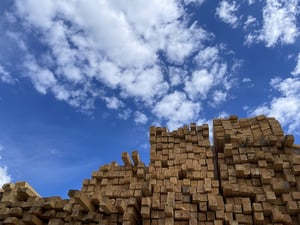In the ever-evolving construction industry landscape, sustainability has moved from a niche interest to a central focus for developers, architects, and builders in the United States. With the U.S. setting ambitious climate goals, including a more than 50% reduction in greenhouse gas (GHG) emissions economy-wide by 2030 and a net-zero emissions economy by 2050, materials used in buildings are increasingly becoming a target for sustainability initiatives.
This shift is also a reflection of a growing societal demand for environmentally responsible building practices. Since commercial and residential buildings account for 36% of total U.S. emissions, with a significant portion from the building materials themselves (embodied carbon), the need to adopt green building materials is becoming stronger.
Understanding the current trends in sustainable materials is crucial for industry professionals looking to capitalize on these changes.
10 Green Building Materials to Consider in Your Next Project
1) Recycled Plastics
Plastics account for 12% of municipal waste in the United States, and the construction industry utilizes 20% of all plastic annually. Reducing virgin plastic use in the construction industry is critical in tackling this waste and associated emissions.
Recycled plastics present a dual solution, limiting the need for new plastics and reducing the amount of existing plastic that enters landfills. Plastic waste can be turned into various products, from decking to insulation, that maintain the same quality as new plastic products. Pretty much any existing product made of plastic can also be made of recycled plastic — the opportunities are nearly endless.
2) Engineered Wood Products
 The building sector utilizes 66% of all solid wood products annually in the United States. Engineered wood, such as mass timber and cross-laminated timber (CLT), offers a sustainable alternative to traditional lumber and concrete. CLT is made from layers of compressed wood, and it is not only stronger and more durable but also acts as a carbon sink, storing carbon dioxide until it decomposes — unlike concrete.
The building sector utilizes 66% of all solid wood products annually in the United States. Engineered wood, such as mass timber and cross-laminated timber (CLT), offers a sustainable alternative to traditional lumber and concrete. CLT is made from layers of compressed wood, and it is not only stronger and more durable but also acts as a carbon sink, storing carbon dioxide until it decomposes — unlike concrete.
3) Recycled Steel
Steel recycling is a mature industry that boasts significant energy and emissions savings over producing new steel. In fact, recycled steel produces up to 58% less emissions than new steel. Recycled steel holds the same properties as virgin steel, yet with a lower environmental cost. Additionally, recycled steel is often cheaper than virgin steel because it removes the need for expensive mining and a lengthy supply chain.
4) Bamboo
 Bamboo has long been used for building in countries throughout Asia. However, it has remained niche in the United States. Renowned for its rapid growth and strength, bamboo is a sustainable superstar. It can regenerate without replanting, has the tensile strength of steel, and has greater compressive strength than concrete.
Bamboo has long been used for building in countries throughout Asia. However, it has remained niche in the United States. Renowned for its rapid growth and strength, bamboo is a sustainable superstar. It can regenerate without replanting, has the tensile strength of steel, and has greater compressive strength than concrete.
While its main issue is poor durability — it decays in its natural state — using it in tandem with traditional building materials is viable. It can be an efficient alternative to steel in reinforced concrete at a fraction of the cost and emissions.
5) Rammed Earth
Rammed earth is a technique that has been used for centuries and is making a comeback in sustainable design. It involves compressing a mixture of natural materials like soil, clay, and natural fibers to create solid walls.
It has excellent thermal regulation properties, helping maintain indoor temperatures naturally, has high strength and durability, and requires minimal maintenance. This makes it an exciting alternative to concrete.
6) Low Carbon Concrete
Concrete is essential in construction but traditionally has a high carbon footprint — 1.5% of all U.S. emissions annually. The majority of emissions in concrete come from cement used in the mix. By replacing a portion of the cement with low-carbon alternatives, like fly ash or waste silica, the emissions can be significantly reduced. While still more expensive than traditional concrete, as demand increases, costs will decline.
7) Hempcrete
Hempcrete is a lightweight, biodegradable material made from the inner woody fibers of the hemp plant mixed with lime and water. While its name makes it seem like an alternative to concrete, it is lightweight and can’t be used as a load-bearing material.
Alternatively, it is a low-carbon insulation used as a substitute for standard foam and plastic-based insulations. It provides excellent natural insulation and is carbon-negative, absorbing more CO2 during its growth than is emitted during production.
8) Cork
 Cork is not just for wine bottles. Harvested from the bark of cork oak trees without harming the tree, cork is lightweight, renewable, recyclable, and provides excellent thermal and acoustic insulation. It is even used in outer space as a thermal insulator for spacecraft. These qualities make it a prime choice for flooring and wall covering.
Cork is not just for wine bottles. Harvested from the bark of cork oak trees without harming the tree, cork is lightweight, renewable, recyclable, and provides excellent thermal and acoustic insulation. It is even used in outer space as a thermal insulator for spacecraft. These qualities make it a prime choice for flooring and wall covering.
9) Recycled Glass
Glass is a core component of building design, used for windows, insulation, and structural components. However, glass production has significant environmental impacts related to silica mining and emissions from production.
Recycled glass consists of crushed glass from previous products that is reheated and melted together. This significantly reduces embodied emissions, virgin material requirements, and production inputs like water. Beyond entirely glass products, recycled glass can be transformed into tiles, countertops, and even used as an aggregate in concrete, providing an aesthetically pleasing, durable, and sustainable option.
10) Mycelium
While not nearly as prevalent as the previous options, mycelium (fungus) is on the cutting edge of sustainable materials. Mycelium is combined with agricultural waste to form a densely interconnected structure within a mold of whatever shaped component is desired. This means it is all-natural, making it a carbon sink without mining requirements.
One promising option is mycelium bricks, which can be stacked as an alternative to concrete. The major downside is that its compressive strength is just a fraction of concrete. However, it is significantly lighter than concrete, so it is a good option to consider for weight-restricted projects.
Embracing the Green Building Revolution
The shift towards sustainable building materials is an environmental choice and a strategic business decision. By adopting these materials, developers can reduce the environmental impact of their projects and position themselves ahead of the regulatory curve. Furthermore, these options are a great solution for projects aiming for LEED certification, which tenants and would-be purchasers continue to place more value on.
Emerald Built Environments has decades of experience integrating sustainable practices into the built environment. Our expertise in green building strategies and materials can help you navigate the complexities of sustainable development, ensuring your projects not only meet but exceed your sustainability goals. Learn how we can help you make your next build green!
Posts by Tag
- Sustainability (171)
- sustainability consulting (143)
- Energy Efficiency (126)
- Utilities (91)
- LEED (87)
- Sustainable Design (69)
- green building certification (59)
- energy audit (46)
- ESG (45)
- construction (43)
- GHG Emissions (36)
- WELL (32)
- carbon neutrality (31)
- net zero (27)
- tax incentives (27)
- costs (26)
- energy modeling (18)
- electric vehicles (17)
- Energy Star (14)
- Housing (14)
- Inflation Reduction Act (13)
- water efficiency (13)
- Social Equity (12)
- decarbonization (12)
- diversity (10)
- NGBS (7)
- fitwel (7)
- Earth Day (6)
- electrification (5)
- mass timber (5)
- non-profit (5)
- retro-commissioning (5)
- Emerald Gives (4)
- Engineering (4)
- News Releases (4)
- B Corp (3)
- COVID-19 Certification (3)
- Customers (3)
- Indoor Air Quality (3)
- PACE (3)
- Arc (2)
- DEI (2)
- EcoDistricts (2)
- EcoVadis (2)
- Green Globes (2)
- cannabis (2)
- CDP (1)
- SITES (1)
- furniture (1)
- opportunity zone (1)
- womenleaders (1)


